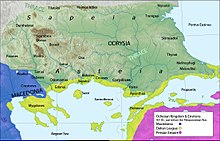


The Dentheletae (Greek: Δενθελῆται), also Danthaletae (Δανθαλῆται) or Denseletae, were a Thracian tribe that in antiquity lived near the sources of the River Strymon, and are mentioned in texts by Polybius, Cassius Dio, Tacitus and by Livy. They lived in the neighbourhoods of the modern towns Kyustendil (ancient Pautalia) and Dupnitsa (ancient Germania, from the Thracian word for "hot", due to its springs), stretching to as far as the mountains to the west towards the valleys of the Morava and the Vardar river, with territories situated next to the Thracian tribes Agrianes (per Theopompus) and the Maedi (per Strabo). Their main city, called Dentheletica, was presumably Pautalia (modern-day Kyustendil) as this was the capital of the Roman region Dentheletica. They possibly built fortifications around Stara Planina in the 1st century BC, lived around Sofia and Skaptopara (modern Blagoevgrad) was their town.
Livy mentions them in passing in his account of King Philip V of Macedon, who in 214BC plundered them for supplies even though they were his ally. The Dentheletae were allies of Rome. Along with the Scordisci, the Dentheletae invaded Macedonia.
Circa 30BC, when under their king 'Sitas, who was blind', and whilst under treaty with Rome, their territories were invaded by the Bastarnae. In response to this invasion and with the wider objective of securing the Macedonia/Thrace frontier of the Roman Empire, Consul Marcus Licinus Crassus Dives (grandson of Crassus the triumvir) earned a triumph for his attack on the Bastarnae in defense of the Denteleti in 28-29BC with Legio IIII Scythica, Legio V Macedonica and possibly Legio X Fretensis.
Raids in Dardania 16-13BC marked the end of the Dentheletae.
In late antiquity, the area of the Dentheletae was Greek-speaking.
See also
References
- Strabo. Geographica. Vol. vii. p. 318. Page numbers refer to those of Isaac Casaubon's edition.
- Stephanus of Byzantium. Ethnica. Vol. s.v.
- Cicero, in Pis. 34; Pliny. Naturalis Historia. Vol. 4.11.
- "Dictionary of Greek and Roman Geography (1854), DAAE, DECIUM, DENTHELE´TAE".
- Papazoglu 1978, p. 101.
- The Cambridge Ancient History: pt. 1. The prehistory of the Balkans; and the Middle East and the Aegean world, tenth to eighth centuries B.C. Cambridge University Press, 1991. University of Minnesota/ The only writer who describes the Agrianes (under the form Agrii) as Thracians, is Theopom- pus (f 257(a)), but his evidence, isolated as it is, carries less weight.28 To the south of these two tribes lived the Dentheletae,29 in the neighbourhood of the towns of Stanke Dimitrov and of Kjustendil (Pautalia), as well as in the mountains to the west towards the valleys of the Morava and the Vardar
- A History of Macedonia
- The Provincial Rome
- "Heart of Bulgaria's Southeast". Archived from the original on 2016-08-08. Retrieved 2016-05-29.
- Sitzungsberichte
- Ab Urbe Condita, Book XL, pp22, Livy
- The Student's Roman Empire: A History of the Roman Empire from Its Foundation to the Death of Marcus Aurelius (27 B. C.--180 A. D.)
- Appian and Illyricum
- Pannonia and Upper Moesia (Routledge Revivals):
- Historia Romana, Book LI, pp23, Cassius Dio
- The Legions of Rome, Stephen Dando-Collins, pp216, Quercus (December 2010)
- The Legions of Rome, Stephen Dando-Collins, pp212-6, Quercus (December 2010)
- Petrović & Filipović 2013, p. 40.
Sources
- Papazoglu, Fanula (1978). The Central Balkan Tribes in pre-Roman Times: Triballi, Autariatae, Dardanians, Scordisci and Moesians. Amsterdam: Hakkert. ISBN 9789025607937.
- Petrović, Vladimir P.; Filipović, Vojislav (2013). "Epigraphic and archaeological evidence contributing to identifying the location and character of Timacum Maius". Balcanica (44): 35–49. doi:10.2298/BALC1344035P. hdl:21.15107/rcub_dais_4355.